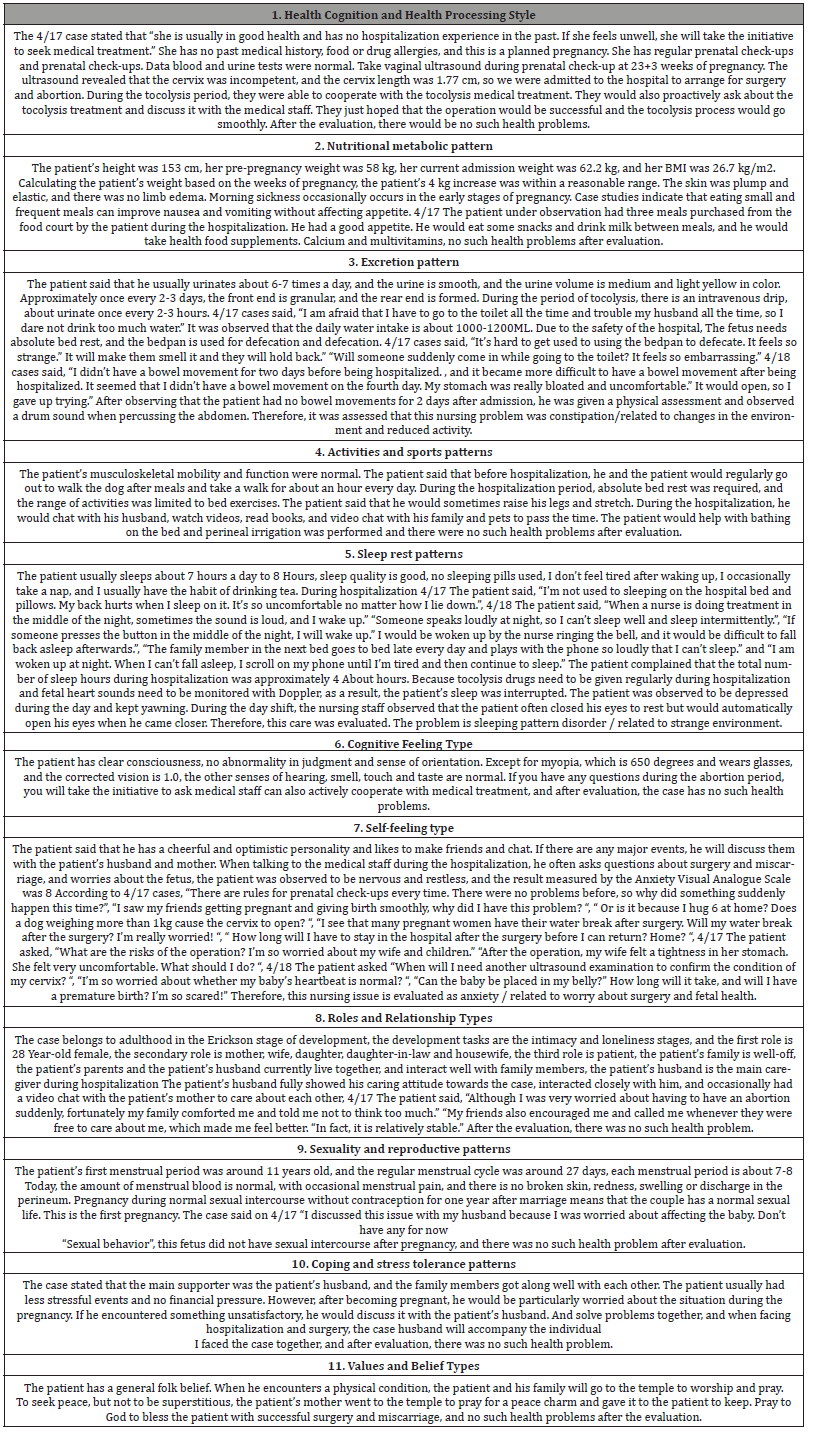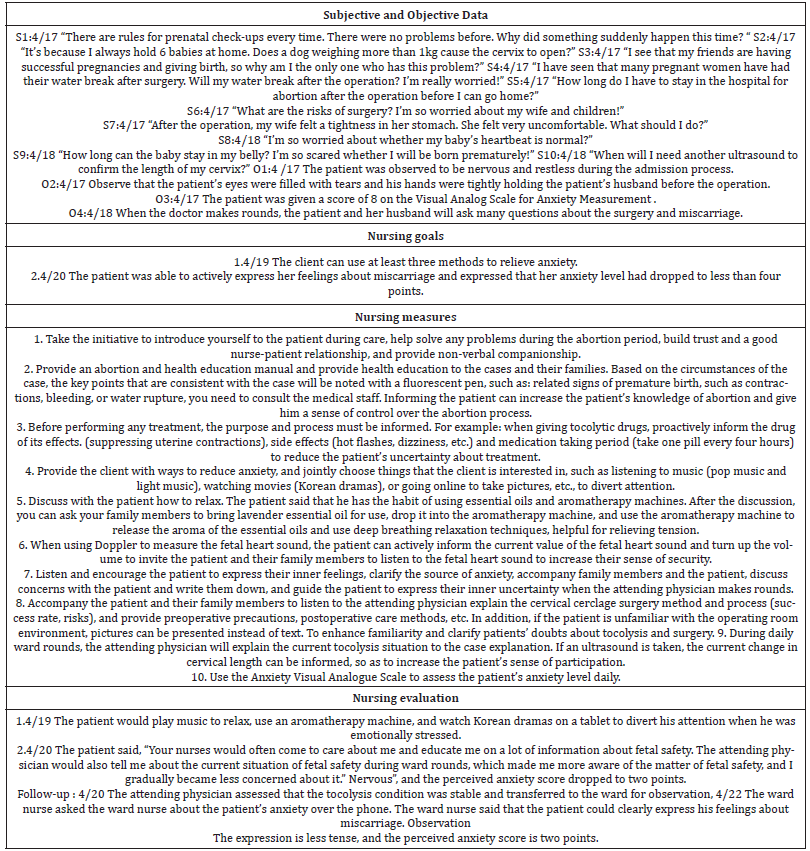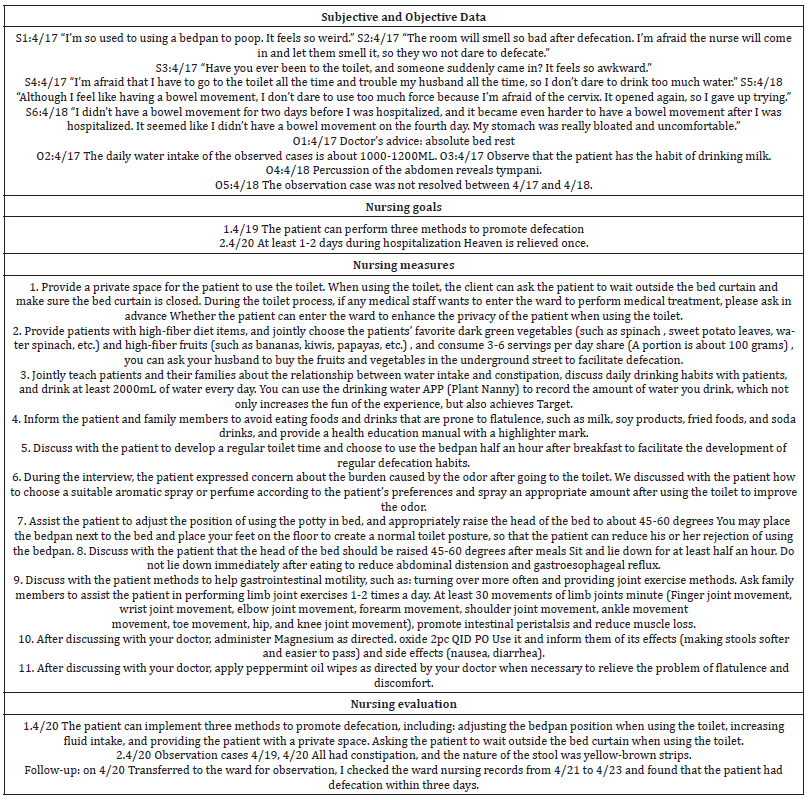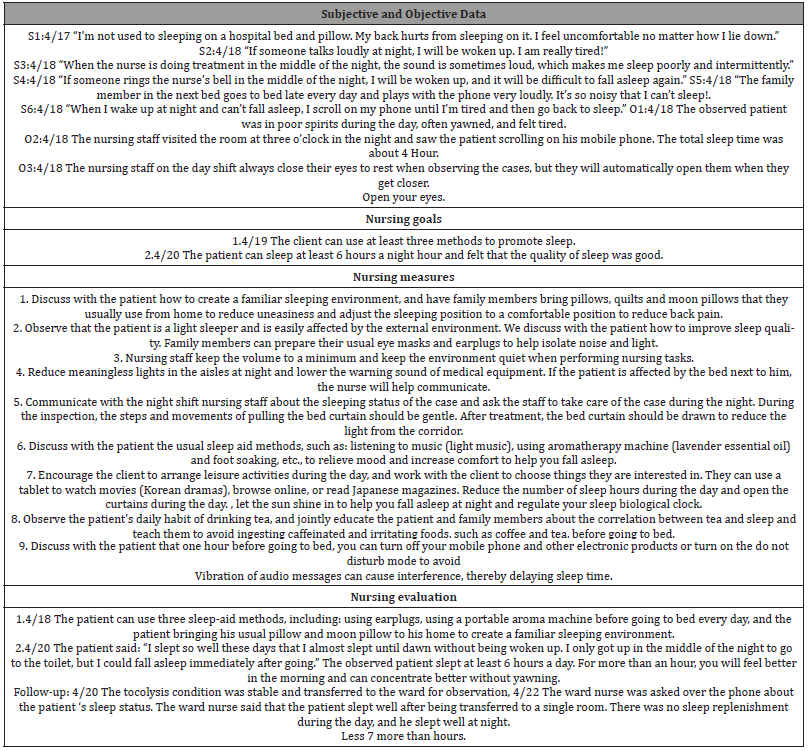 Case Report
Case Report
Experience in Tocolysis Care for Pregnant Women After Cerclage Surgery for Incomplete Cervical Atresia
Yulin XU1 and Wen Hui Lee2*
1Officer of Delivery Room, Department of Nursing, Chang Gung Memorial Hospital, Taiwan
2Officer of Maternity Ward, Department of Nursing, Chang Gung Memorial Hospital, Taiwan
Wen Hui Lee, Officer of Maternity Ward, Department of Nursing, Chang Gung Memorial Hospital, Taiwan
Received Date:June 17, 2024; Published Date:July 01, 2024
Summary
This article describes a primigravida who conceived naturally with singletons at 23+3 days of pregnancy. Peripheral factor cervix Nursing experience for patients with atresia insufficiency who were admitted to the hospital for tocolysis after cervical cerclage. During the nursing period, 2022 Year 04 Month 17 until 2022 Year 04 Month 20 On this day, the author uses Gordon Eleven items of health Functional patterns are assessment tools through direct care of patients, physical assessments, interviews, and observations. Methods are used to collect data and establish that the main nursing issues of the case are: 1. Anxiety / related to worry about surgery and fetal health; 2. Constipation / related to changes in the environment and reduced activity; 3. Sleep pattern disorders / related to unfamiliar environments, etc. health issues. Establish a good nursing relationship with the patient during the abortion period, provide surgery and abortion-related health education, and also provide care according to the patient’s preferences. Choose music, aromatherapy, etc. to relieve anxiety; for individual cases caused by inability to stay in bed during pregnancy Sense of control, providing individualized care by teaching bedpan posture and dietary hygiene Wait to improve constipation; create a comfortable sleeping environment and use sleep aids to help you sleep. Due to limited clinical space, caregivers’ worries are easily ignored. Improper care may have adverse effects. It is recommended to provide a separate space to facilitate the caregiver. To express their inner feelings and help cases and their families establish a solid support system, the author hopes to use This article allows nursing staff to provide psychological support and accompany pregnant women in caring for pregnant women who have to undergo abortion. Can go through the process of hospitalization for abortion.
Keywords:Cervical insufficiency; Cervical cerclage surgery; Tocolysis
Preface
Pregnancy is a special process for women. It should be a happy thing. However, Premature birth without warning causes pregnant women to feel anxious and uncertain [1]. According to the National Health Service of the Ministry of Health and Welfare 2020 The annual birth statistics report shows that in recent years, an average of about 160,000 newborns are born in Taiwan every year, of which premature babies account for 10.53% [2]. The birth of premature infants will not only be complicated by many complications, such as retinopathy, respiratory distress, chronic lung disease, etc., but may be fatal in severe cases. All conditions will cause severe psychological trauma to pregnant women. However, cervical insufficiency is one of the factors leading to premature birth, and the incidence rate among pregnant women with premature birth is as high as 75%. [3], clinically, in order to avoid premature birth, cervical cerclage surgery is mostly performed to extend the number of weeks of pregnancy. The relative surgical procedure is accompanied by high risk factors, such as post-operative infection and water rupture during the surgery [4]. Therefore, what follows after the operation is admission to the hospital for tocolysis treatment. During the hospitalization, absolute bed rest is required. At this time, the pregnant woman will be under great physical and mental pressure. Whether it is about her own health or the health of the fetus, the pregnant woman will be extremely anxious, at this time, the support of spouse and family is very critical [5].
The cases in this article are 28 I got pregnant for the first time at the age of 23. I had regular prenatal checkups and no abnormalities. This time I was 23+2. During the weekly prenatal check-up, it was found that the cervix was incomplete, and the length of the cervix was about 1.77 Centimeters later, arrangements were made for admission to the hospital the next day for cervical cerclage and fetal anesthesia observation. This was the first time the patient was hospitalized. During the hospitalization, he felt very frustrated due to the change in living environment, being absolutely bedridden, and worrying about premature birth. At the same time, he had to rely on the assistance of his caregivers in daily life. He lost his sense of self-control and disrupted his original routine.
This motivated the author, hoping to increase his self-esteem by providing individual care during the care period. The sense of control relieves the patient’s anxiety and creates a comfortable environment to help the patient overcome the difficulties faced during the abortion period. Physical and mental pressure, and provide nursing staff with reference for future care, thereby improving the quality of care.
Literature Review
Introduction to cervical atresia and postoperative care after cervical cerclage
Cervical atresia is one of the causes of premature birth in the second trimester. The current pathological cause is Still unclear, usually associated with a shortened cervix and characterized primarily by the absence of any uterine retraction contraction, causing spontaneous dilation of the cervix [6]. In the face of cervical insufficiency, cervical cerclage surgery is one of the most commonly used methods. and removal are relatively easy, so it is more widely used [4]. Usually recommended at 24 months of pregnancy Surgery was performed before 36-38 weeks of pregnancy. When the cerclage is removed, it maintains the structural integrity of the cervix and prolongs pregnancy [6], and the accompanying tocolysis methods after surgery include bed rest and antibiotics to reduce infections caused by invasive treatments and the use of tocolysis drugs, so as to prevent uterine contractions after surgery [1].
The physiological impact of tocolysis on pregnant women and their care
The main goal of tocolysis is to prolong the number of weeks of pregnancy, and bed rest is often used as a treatment method. It can increase placental blood flow and reduce fetal pressure on the cervix. However, long-term bed rest Pregnancy causes the gastrointestinal motility of pregnant women to slow down, which can easily cause abdominal distension and constipation [7]. The nursing measures that can be provided for this problem can be divided into non-drug treatment and drug treatment. (1) Non-drug treatment: 1. Improve your diet. It is recommended to eat small amounts with frequent meals, choose easily digestible foods, and avoid intake of gas-producing foods, such as beans, milk, etc., and consume more fiber-rich vegetables. With fruits, such as spinach, sweet potato leaves, bananas, etc., adults are recommended to consume 25-30g per day. and increase water intake at least daily 2000ML [8]; 2. Change living habits, because most absolutely bedridden pregnant women have never used a bedpan. The correct way to use the bedpan can be taught, and a private environment and a fixed defecation time can be provided. The reflex usually occurs half an hour to an hour after a meal, so it is recommended that setting the defecation time after a meal and raising the head of the bed after three meals can reduce the occurrence of gastroesophageal reflux and flatulence [9]. In addition, if you are worried about the odor after using the toilet in bed, you can choose your favorite aromatic spray or perfume and spray an appropriate amount to improve the odor after using the toilet; 3. Increase your activities. Since the number of activities in bed is limited, inform the extent of activities you can do in bed, such as: turning over frequently to change postures and limb joint movements, etc., to increase intestinal peristalsis and help exhaust gas [10]. (2) In terms of drug treatment, if the flatulence is uncomfortable, you can provide peppermint oil for wiping. If necessary, give stool softeners and probiotic supplements as directed by the doctor. The probiotics contain fructooligosaccharides to help the growth and utilization of beneficial bacteria, which can promote gastrointestinal motility and defecation [11].
During in-hospital tocolysis, various noises in an unfamiliar environment will affect the tocolysis process of pregnant women. Sleep quality. Poor sleep quality will have adverse effects on the body, health, and mood [12]. Therefore, appropriate nursing measures can be provided, including opening the curtains in the ward during the day to allow sunlight to shine in and fade away the sleep quality. Melanin secretion can increase the overall sleep time [13]; during nighttime collection and care, medical staff should reduce unnecessary conversations. In addition to lowering the warning sound of medical equipment and adjusting the lights on the aisle, they can also Family members can be invited Prepare eye masks and earplugs to reduce sleep disturbance factors and bring your usual bedding products at home to create a familiar sleep environment [14]; at the same time, teach relaxation techniques, such as listening to listen to soft music, use aromatherapy, massage and warm foot soaks to improve sleep comfort, and We teach you to avoid drinking caffeinated drinks such as coffee and tea before going to bed to improve the quality of your sleep at night [5]. In addition, modern people use mobile phones frequently and like to finish swiping before going to bed. If you don’t fall asleep after using a mobile phone and use your mobile phone in a dark environment, the blue light emitted by the screen will stimulate your brain. It partially interferes with the secretion of melatonin and affects the body’s biological clock, thereby delaying sleep time. Therefore, it is recommended to turn off your mobile phone or use the do not disturb mode one hour before going to bed to reduce the urge to think about messages when you see them. The situation of reply [15].
The psychological impact of tocolysis on pregnant women and their care
During pregnancy, pregnant women will face four psychological tasks, which are usually directly or indirectly cause psychological stress to pregnant women, the main reason is usually “to ensure the safety of mother and baby”, and anxiety is a common emotional manifestation of human beings when facing stress. If the state of anxiety remains unchanged for a long time, Kindness will seriously affect physical and mental health [8]. Therefore, caregivers can Consider the visual analog scale to understand the level of perceived anxiety among pregnant women undergoing tocolysis, with a score of 0 to 10 Divide, divide the higher the number, the greater the anxiety. It is very important that early detection and appropriate intervention can be provided during care. What is important [12] is to first establish good therapeutic interpersonal relationships with the case and conduct regular follow-up visits. Provide companionship according to individual cases, encourage them to express their inner feelings, listen and clarify the sources of anxiety, and provide appropriate Provide relevant information and care measures and encourage family members to participate in the abortion care process to create a supportive environment [16]; however, when pregnant women are worried about the uncertainty of surgery and tocolysis, not only Can provide relevant health education and manuals, such as : preoperative health education including process and environment, postoperative related photos care, precautions for signs of premature labor and perineal flushing to increase awareness of tocolysis [17], and can also teach relaxation and distraction techniques, such as reading books, deep breathing techniques, and listening to your favorite music to maintain a happy mood [18] or optional Using lavender scented aromatherapy not only relieves anxiety, but also helps relax muscles. sleep and other functions [19]; in addition, when the fetal heart sound measured with Doppler is related to the device When using the contraction monitor, proactively inform the patient of the current fetal heartbeat and uterine contractions, as well as when the doctor makes rounds Remind doctors to explain the current fetal safety situation and ultrasound examination results to pregnant women, so that pregnant women can be more aware Understand your own miscarriage status [5].
Nursing Process
Case introduction
Miss Lu, 28 Years old, college graduate, married, working as a housewife, with a well-to-do family economy, accustomed to speaking Mandarin, religious beliefs as common folk beliefs, no past medical history, or allergies, Currently, she lives with the patient’s parents and husband, and she is taken care of by the patient’s husband during the hospitalization period.
Maternity and childbirth history
The case’s first menstrual period was approximately 11 Years old, regular menstrual cycle is about 27 days, each menstrual period is about 7-8 days, normal menstrual flow, occasional menstrual pain, pregnancy, and childbirth history G1P0, expected delivery date is 2022 Year 08 Month 11 On this day, this fetus is pregnant with 23+3 Weekly pregnancy of singletons naturally.
Medical treatment process
After the pregnancy, this fetus occasionally experienced uterine contractions and was depressed. She did not take any tocolytic drugs and was delivered regularly. There was no abnormality in the inspection. in 2022 Year, 4 Month 16 A cervix was found during vaginal ultrasound during the Japanese obstetric examination insufficiency of atresia and cervical length 1.77 Centimeters, due to the small gestational age, it is scheduled for 2022 Year 4 Month 17 After hospitalization on the morning of the same day, cervical cerclage surgery was performed, and the fetus was observed.
Nursing Assessment
Nursing period from 2022 Year 4 Month 17 until 2022 Year 4 Month 20 On that day, the author served as the main nurse during the abortion period of the case. During the care, I used observation, interview skills, physical assessment, etc. method to collect data and use Gordon Eleven functional health types, data collection and analysis are as follows:
Table 1:

Establish the Problem
viaGordon After eleven functional health assessments, the cases identified were “anxiety / related to worry about surgery and fetal health”, “constipation / related to changes in environment and reduced activity level” “Related”, “Sleep pattern disorder / related to unfamiliar environment”, and targeted at the above three health issues an in-depth discussion of the topic and nursing plan are as follows:
Nursing measures
1. Anxiety / related to worry about surgery and fetal health (2022/4/17-2022/4/20)
Table 2:

2. Constipation / related to environmental changes and reduced activity (2022/4/17-2022/4/20)
Table 3:

3. Sleep pattern disorder / related to unfamiliar environment (2022/4/17-2022/4/20)
Table 4:

Discussion and Conclusion
This article describes a 23+3 Pregnant women were admitted to the hospital for tocolysis after cervical cerclage surgery due to the discovery of incompetent cervix during prenatal check-ups. During the hospitalization, they suffered from physical discomfort due to bed rest, worry about the risks of surgery and psychological problems derived from premature birth of the fetus. During the hospitalization, the cases continued to repeat. Ask medical staff questions about the status of surgery and tocolysis and use Tu et al.’s [12] anxiety visual analog scale to find that the patient is currently in a state of anxiety. In terms of care, the author relied on Lin and Huang’s [8] literature to propose establishing good nursing care for the patient. Due to the relationship between the disease and the disease, the patient was given surgery and fetal safety education manuals when he was admitted to the hospital and was encouraged to express his inner worries. Afterwards, the nursing staff listened, accompanied, and encouraged the patient. The patient was obviously more relaxed. The patient was also able to divert his attention by browsing online movies and watching Korean dramas., the anxiety visual analog scale dropped to two points; the need for absolute bed rest and environmental changes after surgery led to constipation problems. According to Huang and He [8], it was pointed out that through high-fiber diet, water intake, and providing hidden After providing a tight toilet environment and being taught how to use the bedpan, the patient was able to defecate on the bed smoothly; during the period of pregnancy, the patient suffered from sleep disorders due to not adapting to the unfamiliar environment. Through the literature of Wu and Chen [14], the care and use during collection were proposed the usual bedding products are used to enhance the sense of security and earplugs are used to reduce external noise and improve sleep. In addition, the patient usually uses aromatherapy.
Oil is used to aid sleep. The author uses aromatherapy to relax the patient’s muscles and thereby improve sleep quality. However, since the fetal safety area is currently only separated by bed curtains, the sound insulation and privacy are relatively low. Inadequately, each family has different schedules, and it is easy for them to interfere with each other, or some family members may remember the wrong bed and go to the wrong room. etc., so it is hoped that the hardware equipment of the ward can be improved in the future, such as: planning out cubicles and it is recommended to change bed curtains to soundproof doors, etc., which can not only provide a private environment for individual cases, but also achieve a good Sound insulation. In addition, the patient’s main caregiver during hospitalization is the patient’s husband. Although he can cooperate with relevant parties during the period of care, the caregiver is unwilling to talk more about his inner feelings during this hospitalization, so he is unable to understand and provide Familycentered care. Due to this limitation and difficulty in caring for the family, it is recommended that another individual the environment is conducive for caregivers to express their inner feelings, and appropriate care and resources are provided. In addition to solving in addition to the physical and psychological problems of the case, it is also necessary to understand the caregiver’s inner thoughts to achieve family-centered care, thereby improving the quality of care.
Acknowledgment
None.
Conflict of Interest
No conflict of Interest.
References
- Li Dairu, Ye Lingya (2018) Care for a primiparous woman with artificial insemination and early-stage water rupture and fetal safety. Journal of Medical Experience and Midwifery 60: 42-50.
- National Health Service (2021) Ministry of Health and Welfare, Executive Yuan. 109 Annual birth notification statistical table.
- Debieve F, Joskin A, Steenhaut P, Bernard P, Hubinont C (2020) Transabdominal Cerclage for Cervical Insufficiency in Twins: Series of Seven Cases and Literature Review. The Journal of Maternal-Fetal & Neonatal Medicine 33(21): 3579-3583.
- Shennan A, Story L, Jacobsson B, Grobman WA, FIGO Working Group for Preterm Birth (2021) FIGO Good Practice Recommendations on Cervical Cerclage for Prevention of Preterm Birth. International Journal of Gynecology Obstetrics 155(1): 19-22.
- Liao Xiuhua, Wu Yuping, Zeng Qiongyi (2019) A patient with pneumonia complicated by respiratory failure was successfully discharged from the respiratory tract Nursing experience of patients with inhalation devices. Antai Medical Journal 25 (1): 47-60.
- Wierzchowska Opoka M, Kimber Trojnar WITH, Leszczynska-Gorzelak B (2021) Emergency Cervical Cerclage. Journal of Clinical Medicine 10(6): 1-12.
- Wei Minyuan, Zhang Shuyun, Gu Xuezhen (2017) A pregnant woman with early uterine contractions faces miscarriage Failure of nursing experience. MacKay Nursing Journal 11(2): 60-70.
- Huang Shiting and He Qianyi (2020) A primiparous woman with amnionocele failed to have an abortion and faced perinatal loss. Luozhi’s nursing experience‧Changhua Nursing 27(2): 46-59.
- Liao Chenjin, Chen Meiling (2021) The nursing experience of a patient with sacral chordoma. NTU Nursing Journal 17(1): 101-113.
- Liu Lanxi, Lin Yuee, Bai Shufen, Wu Xiangling, Hong Xiuqin (2018) Care for a Kuja family Experience in home care of ill patients‧Journal of Long-term Care 22(1): 67-78.
- Yang Huishan, Lu Yunping, Wang Sumin, Xu Nanli (2017) Using abdominal massage to improve long-term sleep disorders an empirical study on the constipation problem among bed-ridden elderly people. Journal of Health and Architecture 4(2): 72-80.
- Tu Liyan, Li Xiulan, Shi Miaofang (2022) Anxiety and its predictors among hospitalized women undergoing tocolysis. Chang Gung Nursing 33(1): 1-14.
- Wu Chunyi, Chen Ruizhen (2019) Using "quiet moments" to improve the sleep of patients in the intensive care unit Quality. Taiwan Medicine 23(5): 632-639.
- Wu Chunyi, Chen Huimei (2020) Non-drug intervention measures to promote sleep quality in critically ill patients. Taiwan Bay Medicine 24(5): 490-499.
- Zhao Chenshen, Zhang Shipei, Yang Changbin (2020) The impact of mobile phone addiction on the sleep quality of college students Xiang Jiada. Journal of Sports, Health, and Leisure 19(1): 40-50.
- Zhang Sewen, Shi Huimei, Wu Sulan, Wang Qi, He Lunhui, et al. (2018) Exploring the self-Anxiety, uncertainty, and anxiety in patients with degenerative knee arthritis treated with high-concentration platelet plasma injection Its related factors. Journal of Health Technology 5(1): 48-67.
- Lin Yiyun, Huang Huiyu (2020) Using Roche adaptive model to care for a patient undergoing left atrial appendage tamponade Nursing experience of surgical patients. Journal of Nursing 37(1): 99-106.
- Cai Yanyun, Shi Huimei, Chen Lizhen, Xu Youying, Xu Rongshan (2020) Music measures intervention Exploring the effectiveness of improving anxiety and comfort in patients with initial endotracheal tube indwelling. Health Journal of Science and Technology 7(1): 1-11.
- Qiu Xuanyu, Yang Xiaoling (2021) Using lavender essential oil and acupoint massage to improve intestinal replication cysts Nursing experience of children with abdominal pain. National Taiwan University Nursing 2(17): 101-112.
- Alfirevic Z, Stampalija T, Medley N (2018) Cervical Stitch (Cerclage) for Preventing Preterm Birth in Singleton Pregnancy. Cochrane Database of Systematic Reviews 6(6): 1-103.
-
Yulin XU and Wen Hui Lee*. Experience in Tocolysis Care for Pregnant Women After Cerclage Surgery for Incomplete Cervical Atresia. Iris J of Nur & Car. 5(1): 2024. IJNC.MS.ID.000604.
-
Cervical insufficiency, Cervical cerclage surgery, Tocolysis
-

This work is licensed under a Creative Commons Attribution-NonCommercial 4.0 International License.






